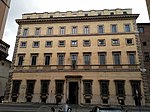Palazzo Mattei
Baroque architecture in RomeHouses completed in the 17th centuryPalaces in RomeRome R. XI Sant'Angelo

The Palazzo Mattei di Giove is the most prominent among a group of Mattei houses that forms the insula Mattei in Rome, Italy, a block of buildings of many epochs.To distinguish this section from the others it carries the name of a Mattei fief, Giove. The Mattei owned a number of other palazzi that carried the family name including Palazzo Mattei di Trastevere across the Tiber as well as properties in Umbria, the Palazzo Mattei Paganica.
Excerpt from the Wikipedia article Palazzo Mattei (License: CC BY-SA 3.0, Authors, Images).Palazzo Mattei
Via dei Funari, Rome Municipio Roma I
Geographical coordinates (GPS) Address External links Nearby Places Show on map
Geographical coordinates (GPS)
| Latitude | Longitude |
|---|---|
| N 41.894071 ° | E 12.478104 ° |
Address
Palazzo Mattei di Giove
Via dei Funari
00186 Rome, Municipio Roma I
Lazio, Italy
Open on Google Maps











